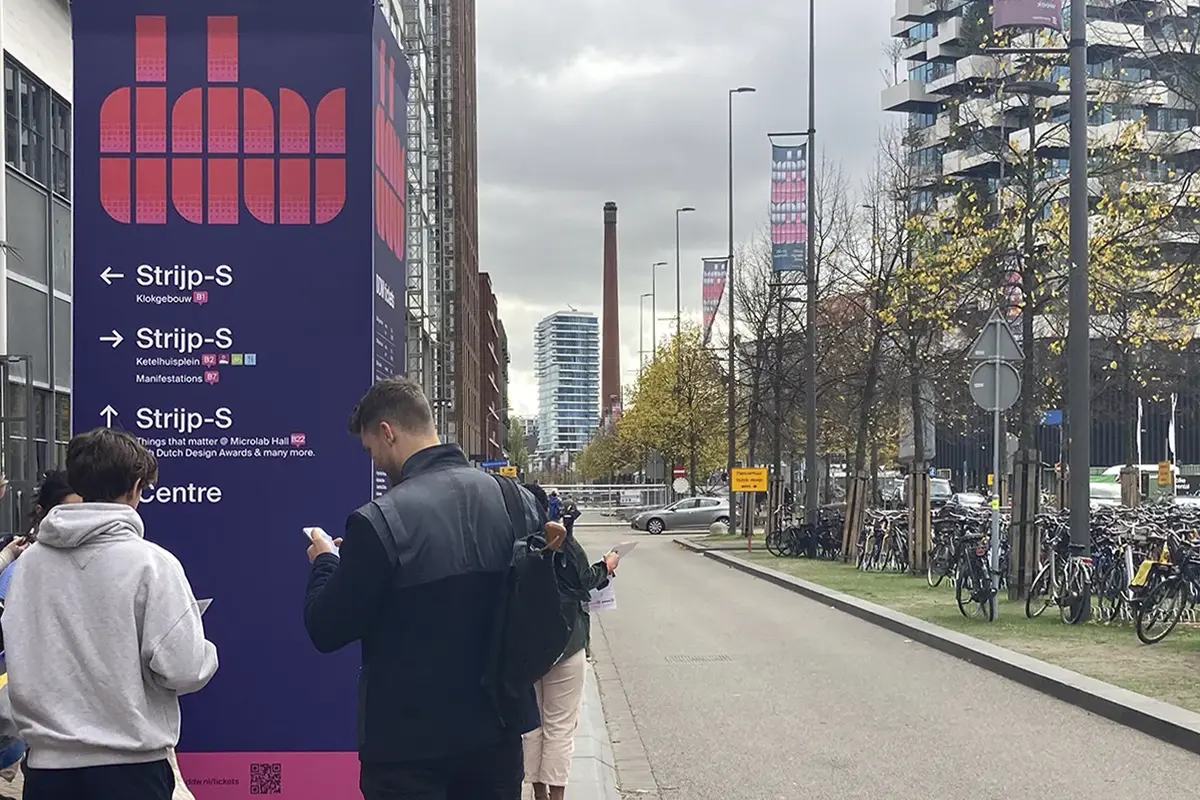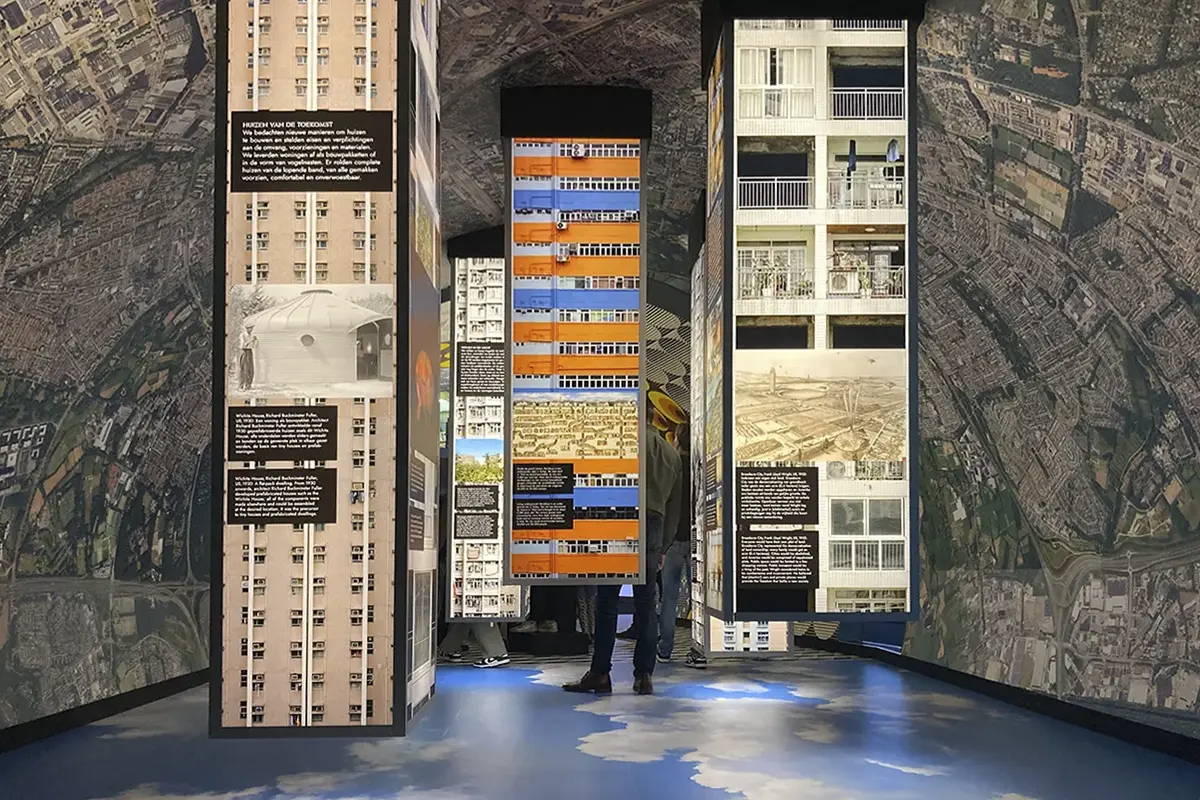Dutch Design Week 2022 presented a debate around a nature-centric future in response to the sustainability issues that we are facing. How can design help in saving the environment?
The DDW of Eindhoven: human impact on the ecosystem and the reorganization of the society
Stepping into the city of Eindhoven for the first time, one might think of a typical Dutch city, with a cloud-filled sky, as many as its bicycles flowing through the city’s veins. One might think of a tidy, clean, efficient city, especially when looked at through the eyes of those living in the south of Europe, unused to such orderly creative ferment.
Yet Eindhoven is much more than that. In fact, the Dutch city aims to translate the Dutch cultural context and social organization into practical and applicable, but even more extensible, solutions. The Dutch cultural model appears as an alternative and flourishing solution for a more inclusive, more equitable and progressive society.
Dutch Design Week is imbued with Northern European pragmatism, reflecting on the concrete possibilities for design to improve the quality of life and positively affect human impact on the ecosystem and reorganize society in a brand new way.
What supermarkets and food will look like in the near future
Among the many projects is one related to the issue of food – food production and food distribution in the near future. It is not just a matter of predicting the future, but an investigation of how technology and research will directly influence the relationship between humans and food in the coming years, by virtue of a greater reduction in environmental impact, food waste, and the targeted health of consumers depending on their profile.
The Embassy of Food and the scenarios on the function the supermarket in 2050
Together with designers, the students of the Technical University of Eindhoven and Embassy partners, The Embassy of Food developed different scenarios for the supermarket of the future. This was done in the form of an Embassy Lab, in which they gave the design studios involved, Studio Merle Bergers and Nonhuman Nonsense, and the students a specific design challenge. They developed three different scenarios to investigate what function the supermarket might play in 2050, imagining for example that it could play the role of Lifestyle Coach, where people’s data is used to generate nutritional advice.
A matter of design: food transition, production techniques and culinary habits
Thus the project becomes a manifesto that raises questions about the issue of food, as this will be one of the burning issues facing the planet when it interfaces with overpopulation, and thus inevitably crucial to modern-day design.
We are in the middle of a huge food transition that puts to the test how we use our existing raw materials, production techniques and culinary habits. We are all looking for more sustainable, honest and healthy alternatives for a better world. Also for even more convenience, personalisation and digitisation. These developments will change the food-chain as we know it.
«No one knows what supermarkets will look like in thirty years, or even whether the supermarket as we know it will even still exist. Will we still physically do groceries in the future or will everything be delivered to our homes? And will we still be eating animal products, exotic crops and sweets? The Embassy of Food does not answer these questions directly, but aims to present various different scenarios for the supermarket of the future. Meat without animals, milk without cows, functional food, groceries delivered to your door within ten minutes and digital dining».
Exploring the building blocks for a nature-centric future
Among the exhibition pavilions in Eindhoven, it is not solely about food. Recurring themes also include how to actively engage design in creating a nature-centric environment that departs from the anthropocentric view of the post-industrial era. Bringing nature back to the center, then. But how to do this? Some projects seek answers through raising awareness and proposing new scenarios.
Expedition Æqualis is an ongoing, interdisciplinary design-research project by Dutch Invertuals in collaboration with The Future Laboratory, Edhv and Reon Brand (Philips Experience Design). Together, they have embarked on a three-year transformative exploration towards an eco-centric future where humans are, and want to be, part of a healthy and balanced ecosystem.
Expedition Æqualis
«As a civilization, humanity has reached a point of no return. Around the world, we are facing the perils of accelerating climate change and ecosystem collapse, brought about by our own relentless pursuit of material progress. Difficult choices lie ahead, with no easy solutions to navigating the uncertain future, which may ultimately threaten our own survival as a species
Æqualis focuses on a post-anthropocentric future where humanity transitions to an ecocentric worldview that puts the health of planetary ecosystems above our own needs.
For a long time, humanity has acted like a self-appointed representative of nature. In our pursuit of progress, we have exploited nature as a resource, used science to bend it to our will, and pushed it to its limits by our ideals of endless economic and material growth».
Designing for redemption. Design becomes key in transforming our relationship with the planet
The quest of Expedition Æqualis is to employ design as a creative force to inspire and support humanity to transition to an ecocentric existence. It has been called a ‘designing for redemption’, where design becomes key in transforming our relationship with the planet.
During Dutch Design Week, Expedition Æqualis presented work from eight designers and duo’s who have translated their vision into tangible design manifestations. The exhibition featured work from Johanna Seelemann, Dae Uk Kim, Delphine Lejeune, Edhv, Moonseop Seo x Katharina Sook Wilting, Anna Resei, Studio ThusThat, and Audrey Large x Theóphile Blandet.
Crust series by the Studio ThusThat
«How can we challenge our material expectations based on consumerism and globalized perfection?». This is the question the ThusThat firm asked itself when it thought of a series of objects that reveal an unexpectedly raw backstory to an everyday material. In this work the edges are jagged and roughly cut, resulting in rough shapes that seem to have been the very product of some industrial mechanism.
A factory casting molten aluminum into massive blocks weighing over 25 tons was an early technique in aluminum production. By casting the blocks, undulating, organic textures are created. Blocks are prepared by cutting off the sides, leaving behind thin plates with rough surfaces called crusts.
By presenting aluminum in an unexpected and unknown form, the ‘Crust’ series challenges our expectations of everyday materials. As opposed to ‘sustainability’ in the sense of recycling or byproduct reuse, this paper examines a new approach to materials in a time when resources are finite, secondary materials will become the norm, and eco-centric thinking will alter the aesthetic expectations of materials.
The Cosmic Balance of EDHV
In the Cosmic Balance work conducted by EDHV, the rebalancing force of nature is visualized by accelerating this process on an object that has become a symbol of human intelligence: the smartphone. In this work, between sarcasm and social criticism, useful questions for contemporary design are developed.
What are the balances altered by modern technology? What can we insist on so that we return to a greater attachment to physical reality rather than the virtual, parallel and alienating reality that now pervades our lives. It is a matter of design to raise these questions and find answers. Also because, and herein lies the caveat, nature has the capacity to regenerate itself. Our species does not.
«In our research into the relationship between humankind and nature, we can only conclude that we have moved from inhabiting Earth to over-inhabiting it. But nature has a trick up its sleeve. Nature has the power to restore its cosmic balance even if it has to do so by resetting itself from the elements upwards. And it has, unlike humanity, eternity on its side», conclude EDHV on explaining their exhibition.
Never take out trash. The Nibble bin and the anemones that eat human waste
What if our everyday products are alive? Imaging breathing homes, living coffins and waste-eating bins. The studio of Bob Hendrikx – inventor, architect and bio designer exploring a new world in which our products are living organisms – explores living products to restore humanity’s parasitic relationship with the environment.
Hendrikx’s work starts with one fact: the annual collection and distribution of our waste is equal to six times the distance between the Earth and the Moon. Currently fifteen percent of all CO2 emissions in the world are caused by road transport.
And here comes the study’s somewhat original solution: why not let nature help us with the elimination of the problem, that is, by using microorganisms that decompose the materials we use and throw away every day, becoming our allies in the fight against waste and including them as a link in a circular economy.
Collaborating with intelligent creatures of the planet
«In nature, sea anemones feed on animal and plant waste, bacteria can eat plastic and mycelium has shown to neutralize heavy toxins. If we could learn to collaborate with these intelligent creatures of our planet, it would allow us to process waste locally while restoring native ecosystems. Imagine ecosystems designed for regional waste challenges: Living Bins that eat our trash», Hendrikx’s poster at the Eindhoven exhibition stated.
The project exposed has been named the Nibble bin. An organically shaped hand-blown glass object that can house specially grown sea anemones, which can eat our organic waste and provide a light show through their luminescence. With more than 1,000 colorful species on the ocean floor, sea anemones play a vital role as recyclers in marine ecosystems. In this project, anemones are included as useful elements in the design of new systems for the natural reuse of what our species considers waste.
The DDWof Eindhoven turns issues into solutions
A laboratory of ideas, that of Eindhoven Design Week. But also a hotbed of designers ready for action to turn issues into solutions. Indeed, DDW confirms itself not only as a collective logo for raising awareness of current issues, but also as a European platform for comparing and building a new sensibility in facing the impending challenges of an increasingly interconnected world.
To sum up the propulsive and optimistic spirit of Eindhoven, one could say that it is true, the issues are there. But so are the solutions.
Dutch Design Week 2022 in Eindhoven
Running from October 22-30 in the city of Eindhoven, Dutch Design Week (DDW) 2022 hosted a series of exhibitions and installations, as well as panel discussions and networking events.
Among the main projects were a pavilion with solar panels in bright colors created by solar designer Marjan van Aubel in collaboration with Dutch architecture firm V8 Architects, an exhibition by graduates of Design Academy Eindhoven and an exhibition on the potential of human waste by social designer Fides Lapidaire.
Expedition Æqualis
Æqualis want to connect with designers, researchers, scientists, coders, developers, events, venues, companies, organizations, and other partners from around the globe around the theme of nature-centric future
Studio ThusThat
Based in London and Amsterdam, Studio ThusThat is led by three Innovation Design Engineering graduates from the Royal College of Art and Imperial College London. It exists to improve the understanding of materials in a world of finite resources and demonstrate the potential of waste materials.




















